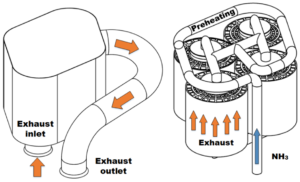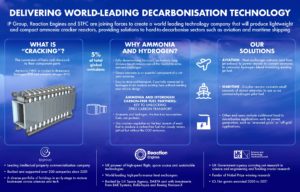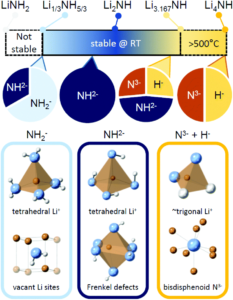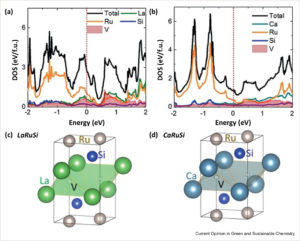Fujitsu and Iceland-based Atmonia will join forces to accelerate catalyst development for the production of ammonia via electrochemical nitrogen reduction reaction (eNRR). By using artificial intelligence and high-performance computing (HPC) technologies, the researchers can conduct “high-speed quantum chemical calculations” virtually rather than via physical experiments, allowing for greater flexibility & speed.
Catalysts
JERA targets 50% ammonia-coal co-firing by 2030
Japanese government funding via NEDO will support four critical ammonia energy projects, including JERA's new plan to demonstrate 50% ammonia-coal co-firing by 2030. Other projects include improved catalysts for ammonia production, low-temperature and low-pressure synthesis pathways, and developing 100% ammonia-fed boilers and gas turbines. In addition, a new cooperation agreement between ASEAN countries will see Japan support other members to adopt their ammonia energy solutions, particularly coal co-firing.
Ammonia combustion analysis: powertrains, turbines & power generation
This week we explore four updates in ammonia combustion R&D:
1. A team from the University of Cambridge has shown merchant vessels are the strongest candidates for conversion to run on ammonia powertrains, with cargo capacity losses of 4-9% able to be feasibly offset by operators.
2. Researchers at the University of Minnesota have successfully tested a thermochemical recuperation (TCR) reactor to improve the efficiency of a dual-fuel, diesel-ammonia compression ignition engine by minimising ammonia slip.
3. A global team led by Cardiff University researchers has revealed some of the inner workings of ammonia combustion in gas turbine flames.
4. A global team has produced a cradle-to-gate environmental assessment for ammonia production and ammonia-based electricity generation, suggesting that renewable and nuclear ammonia have a significant role to play in decarbonising the power sector.
3rd generation ammonia synthesis: new catalysts & production pathways
We look at four new developments this week:
1. A team from DTU Energy and the Dalian Institute of Chemical Physics have uncovered a new class of alternative catalysts for mild condition ammonia synthesis. The ternary ruthenium complex hydrides Li4RuH6 and Ba2RuH6 avoid the energy-intensive pathway of nitrogen dissociation in a "synergistic" manner.
2. A team from the Korea Institute of Machinery and Materials reported a highly selective (95%) plasma ammonia synthesis method.
3. A team from Delft University of Technology has presented an present an "unconventional electrochemical design" that physically separates hydrogen and dinitrogen activation sites.
4. A team at the Max Planck Institute for Coal Research has demonstrated a new mechanochemical ammonia synthesis system that operates at room temperature and pressures as low as 1 bar.
New UK joint venture for lightweight, modular ammonia crackers
Reaction Engines, IP Group, and the Science and Technology Facilities Council (STFC) launched a new joint venture this week at COP26 in Glasgow. The group will design and commercialise lightweight, modular ammonia cracking reactors to enable the use of ammonia in hard-to-decarbonise sectors, particularly aviation, shipping and off-grid power generation applications. The design will feature Reaction Engines’ heat exchanger technology developed for its SABRE™ air-breathing rocket engine. In this setup, exhaust heat is utilised to partially crack ammonia back into a fuel blend that "mimics" jet fuel. STFC will lead development of the cracking catalyst, with funding to be provided by IP Group.
Dynamic Analysis of Flex-gNH3 – a Green Ammonia Synthesis Process
New materials for cracking catalysts
Among the many challenges for cracking researchers is their choice of material to build their catalysts from. There is hope that cheaper, more readily-available materials will replace the Ruthenium-based catalysts that have dominated the field up to this point. This week two new pieces of research suggest a way forwards using alkali metal-based materials: Lithium and Calcium.
Ammonia Energy Live April: low-carbon innovation at Hazer Group
This April we presented a new episode in our monthly webinar series: Ammonia Energy Live. Every month we’ll explore the wonderful world of ammonia energy and the role it will play in global decarbonisation - with an Australian twist. For this episode we welcomed Geoff Ward, CEO of the Hazer Group. Hazer has been steadily developing their novel methane pyrolysis technique in Western Australia with a new low-carbon hydrogen production facility to begin construction later this year. Geoff joined us to reflect on Hazer’s journey so far, familiarise our audience with their processes and give his thoughts on what needs to be put in place for similar decarbonisation projects to succeed. And - of course - we asked Geoff where ammonia fits into Hazer’s future plans! Geoff was interviewed by Andrew Dickson (Development Manager of the Asian Renewable Energy Hub at CWP Global), and Darren Jarvis (Vice President of Strategic Project Development at Incitec Pivot).
The Ammonia Academic Wrap: "seamless" cracking, improving Haber Bosch, a novel green power-to-ammonia-to-power solution and a review into the use of ammonia as a fuel
Welcome to the Ammonia Academic Wrap: a summary of all the latest papers, developments and emerging trends in the world of ammonia energy R&D. This week: "seamless" ammonia cracking tech from Northwestern, a new electrolysis catalyst, successful integration of ammonia synthesis and separation for improved efficiency, more research needed into transition metal catalysts for Haber Bosch, a novel, green power-to-ammonia to power system and a review on ammonia as a potential fuel.









